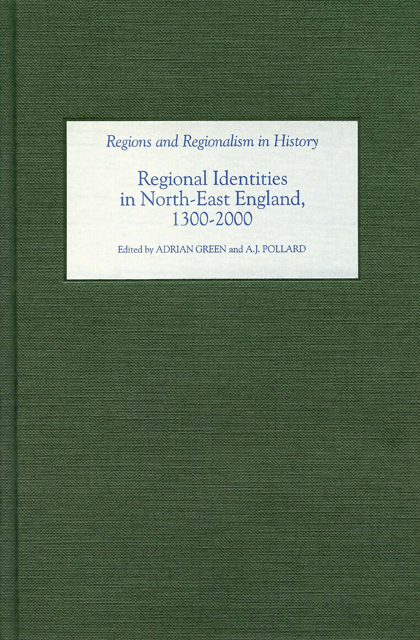Book contents
- Frontmatter
- Contents
- Foreword The AHRC Centre for North-East England History
- Dedication
- Contributors
- Preface
- Abbreviations
- Map
- Introduction Identifying Regions
- 1 North-East England in the Late Middle Ages: Rivers, Boundaries and Identities, 1296-1461
- 2 Borders and Bishopric: Regional Identities in the Pre-Modern North East, 1559-1620
- 3 Law in North-East England: Community, County and Region, 1550-1850
- 4 A Shock for Bishop Pudsey: Social Change and Regional Identity in the Diocese of Durham, 1820-1920
- 5 Business Regionalism: Defining and Owning the Industrial North East, 1850-1914
- 6 Competing Identities: Irish and Welsh Migration and the North East of England, 1851-1980
- 7 Immigrant Politics and North-East Identity, 1907-1973
- 8 Regionalism and Cultural History: The Case of North-Eastern England, 1918-1976
- Conclusion Conclusion Finding North-East England
- Index
1 - North-East England in the Late Middle Ages: Rivers, Boundaries and Identities, 1296-1461
Published online by Cambridge University Press: 10 March 2023
- Frontmatter
- Contents
- Foreword The AHRC Centre for North-East England History
- Dedication
- Contributors
- Preface
- Abbreviations
- Map
- Introduction Identifying Regions
- 1 North-East England in the Late Middle Ages: Rivers, Boundaries and Identities, 1296-1461
- 2 Borders and Bishopric: Regional Identities in the Pre-Modern North East, 1559-1620
- 3 Law in North-East England: Community, County and Region, 1550-1850
- 4 A Shock for Bishop Pudsey: Social Change and Regional Identity in the Diocese of Durham, 1820-1920
- 5 Business Regionalism: Defining and Owning the Industrial North East, 1850-1914
- 6 Competing Identities: Irish and Welsh Migration and the North East of England, 1851-1980
- 7 Immigrant Politics and North-East Identity, 1907-1973
- 8 Regionalism and Cultural History: The Case of North-Eastern England, 1918-1976
- Conclusion Conclusion Finding North-East England
- Index
Summary
Introduction
A good case could be made that it was in the late middle ages that the North East enjoyed its greatest coherence as a region. Recent work has argued for the status of the historic counties of Northumberland and Durham as a distinct ‘cultural province’ within pre-modern England, delineated by two major rivers, the Tees and the Tweed. To the north of the region lay the drainage basin of the river Tweed and to the south was the river Tees, which cut across eastern England for around 100 miles to the sea, following a course through the enclosed environment of Teesdale in the west to the northern edge of the North York Moors in the east. These two physical features and the landscape associated with them, it has been argued, helped to create and define the region of North-East England, within which there was a regional pattern of settlement and network of towns. The North East, in this view, was a single region, determined by natural features of rivers and watersheds.
In the later middle ages, however, Durham and Northumberland were united not simply by natural features but by administrative and cultural connections. From the perspective of Westminster, the historic counties of Northumberland and Durham comprised a single county. For the routine purposes of government, Durham was simply a liberty within this county, a form of devolved local authority whose ruler, the bishop, was ultimately accountable to the crown. In certain circumstances the sheriff of Northumberland could assume jurisdiction there. Northumberland and Durham also formed a single ecclesiastical unit, the diocese of Durham. This administrative unity was reinforced by strong cultural links.The cult of St Cuthbert, whose earlier associations with Scotland tended to beconveniently forgotten, provided common cultural identity within the region. Cuthbert was a northern, even a national, saint, but it seems that he was particularly important within the diocese of Durham.
- Type
- Chapter
- Information
- Regional Identities in North-East England, 1300-2000 , pp. 27 - 48Publisher: Boydell & BrewerPrint publication year: 2007



